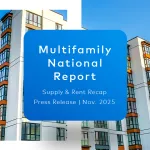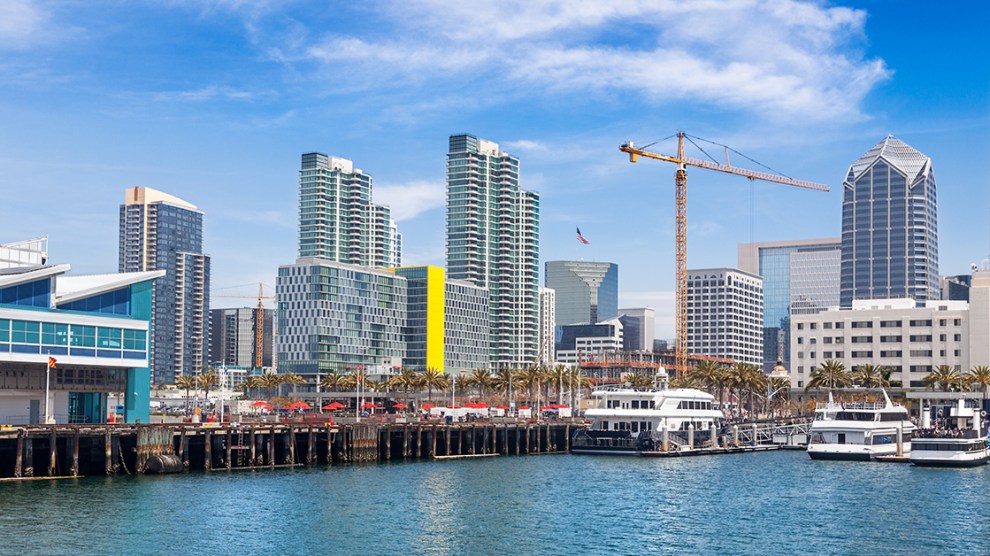Despite mounting headwinds, the average U.S. multifamily asking rent inched up $1 to $1,728 in August, for a 1.5% year-over-year increase.
Report highlights:
- The average asking rent rose 1.5% year-over-year through August, with Northeast and Midwest metros still in the lead.
- Healthy economy continues to create demand. Rents grow inversely proportional to supply expansion.
- Renter-by-Necessity rents up 0.1% month-over-month in August, Lifestyle rents dip into negative territory. Occupancy still at 95.0%.
- Single-family rents increase 0.5% year-over-year in August, to $2,104.
Resilient economy supports multifamily demand
The average U.S. multifamily asking rent rose $1, or 1.5% year-over-year in August to $1,728. The rate was 20 basis points below the July rate and marked a drop of 420 basis points from the beginning of the year. Demand for apartments persisted due to the robust employment market, which added 3.1 million jobs in the 12 months ending in August; meanwhile, unemployment held on at 3.8%. Absorption through July amounted to roughly 190,000 units, which is healthy by historical standards. The best absorption rates by numbers in 2023 so far were registered in Washington, D.C., Phoenix, Miami, Chicago and Denver, while by percentage of stock, Charlotte, Tampa and Nashville occupied the leading ranks.
On a metro level, rent growth remained highly sensitive to supply expansion, with the highest year-over-year rent gains in metros with the weakest supply pipeline: New York City (5.7% year-over-year), New Jersey (5.4%), Chicago (4.9%), Indianapolis (4.8%) and Boston (4.6%). Limited completions also translated into high occupancy rates: New York (98.0%) and New Jersey (97.3%). National occupancy stood at 95.0% for the past four months, positive in just three of Yardi Matrix’s top 30 metros: Chicago (0.3% year-over-year) and New York and Denver (flat). The largest occupancy drops were registered in Austin, Detroit and Atlanta, all down 130 basis points.
Headwinds with likely lasting effects include mounting property expenses and inflation. All types of property expenses have been increasing—insurance (up 18.8% year-over-year in June), repairs and maintenance (14.4%), administrative (11.8%) and utilities and payroll (both 7.8%). Meanwhile, inflation is declining, but is still high and the Federal Reserve chair pointed to possible interest rate increases by year’s end.
Lifestyle rent growth turned negative
Rent growth occurred only in the Renter-by-Necessity segment, up 0.1% month-over-month nationally, while Lifestyle rents contracted 0.1%. Moreover, of Yardi Matrix’s top 30 metros, RBN rents increased in 16 and Lifestyle rents in just 13. On a monthly basis, rent growth was strongest in Kansas City (0.9%), Boston, Los Angeles and New York (all 0.6$) and New Jersey (0.5%). Rent growth was conditioned by supply; with most deliveries in the Lifestyle segment, rent growth in the segment was impaired, dropping by 1.0% in Columbus and Nashville, posting the best monthly performance in Kansas City (up 1.1%).
Renewal rent growth moderated further, rising 7.8% year-over-year in June, 40 basis points below the May rate and on a softening trend since the 11.1% peak recorded in the fourth quarter of 2022. Miami (12.4%), New York City (10.6%) and Orlando (10.4%) had the strongest renewal rent rates. San Francisco (1.8%) posted the weakest rate. meanwhile, the national lease renewal rate stood at 62.9% in June, steadily declining since mid-2022, due to substantial supply brought online.
High-end SFR segment shows signs of softening
The average asking rent for single-family rentals depreciated by $6 in August, to $2,104, marking a 0.5% year-over-year increase and 70 basis points below the July rate. While RBN rents rose 2.9% year-over-year, rents in the Lifestyle segment contracted 0.4%. Occupancy posted a similar dynamic—year-over-year Lifestyle occupancy dropped 100 basis points to 95.3%, and RBN occupancy rose 290 basis points to 97.7%. All in all, the current stats point to softening affordability as prices increase.
Read the full Matrix Multifamily National Report-August 2023.











Add Comment